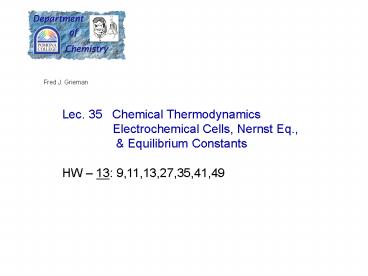Lec' 35 Chemical Thermodynamics - PowerPoint PPT Presentation
Title:
Lec' 35 Chemical Thermodynamics
Description:
High resistance porous filter (Crucible like in Gravimetric Ca2 ! ... Set up crucible with [I-] = 1.0 M & I2(s) Place crucible in beaker, measure Voltage = 0. ... – PowerPoint PPT presentation
Number of Views:35
Avg rating:3.0/5.0
Title: Lec' 35 Chemical Thermodynamics
1
Fred J. Grieman
Lec. 35 Chemical Thermodynamics
Electrochemical Cells, Nernst Eq.,
Equilibrium Constants HW 13
9,11,13,27,35,41,49
2
Electrochemical Cells Chemical Equilibrium
welec -Q?E Q nF wext(max) ?G ?
?G -nF?Ecell (reversible) ?E gt 0
spontaneous Standard States ?G? -nF?E? (1
M concentrations) E come from ½ reactions,
E? are tabulated (but need a
reference !!!) For H(aq) std. state ?G?f,298
? 0 Similarly 2H 2e- ? H2(g) E? ? 0
(reference electrode) Measure
Pt(s)H2(g)H(1M) Fe3(1M),Fe2(1M) Pt(s)
? ?E?298 0.771 V E? (Fe3,Fe2)
3
Standard Reduction Potentials in Table 13-1 and
App. E High Reduction Potential ? Good
Oxidizing Agent Low Reduction Potential ?
Good Reducing Agent Couple ½ rxn high in
table with reverse ½ rxn lower in table
? spontaneous rxn. Example Fe3 e- ?
Fe2 0.771 V at 298 K
2I- ? I2 2e- -0.536 V
(reverse sign!!) 2Fe3 2I- ? I2
2Fe2 0.235 ? E ?298
? E ?298 gt 0 spontaneous (std. state)
?G?298 -nF?E ? -2(96,485)(0.235) -45.4
kJ Keq e-?G?/RT e-(-45.4)/(0.0083145)
(298.15) 8.80 x 107
( )2
Dont multiply by 2!!
4
If instead Fe3 e- ? Fe2 0.771 V
½ I- ? I2 e-
-0.536 V . Fe3 I- ? ½ I2
Fe2 ?E? 0.235
the same!!! Intensive function
Extensive - Now ?G? - F E? (1)FE
-22.8 kJ
? Keq 9.38 x 103 Non-standard state
condition ? ?E and concentrations
? Nernst
Eq. ?GT ?G?T RT ln Q
?G -nF?E -nF?ET -nF?E?T
RT ln Q ?ET ?E?T -
RT/nF ln Q Nernst Eq.
Just ?G in terms of ?E
(DO NOT ?2 !!)
n
5
- at 25?C and log10 ?E298 ?E?298 -
0.0592/n log10Q - Fe3, I- example Pt(s)I-I2(s) Fe3,Fe2
Pt(s) - Rxn Fe3 I- ? ½ I2 Fe2
- ?E298 0.235 V - (0.0592 V / 1) log10
Fe2/Fe3I- - Fe2 0, Q 0 ?Erxn ? 8
- 2) Q Keq ?Erxn 0 ? log10
Fe2eq/Fe3eqI-eq - ?E?298 / 0.0592
0.235/0.592 3.97 - ?
Keq 9.38 x 103 - In general log10 Keq (n ?E? ) / (0.0592) at
298.15 K
6
3) Q lt Keq , ?E gt 0 Q gt Keq , ?E
lt0 e.g., assume all s 0.1
M ?Erxn 0.235 (0.0592/1) log10
(0.1)/(0.1)(0.1) 0.235 0.0592
log1010 0.235 0.0592 0.176 V
spontaneous ! 4) Turn around! Determine Keq
s from ?E measurements a) Fe3, I-
example Pt(s)I-I2(s) Fe3,Fe2 Pt(s)
High resistance porous filter (Crucible like in
Gravimetric Ca2 !!!) Set up beaker with Fe3
Fe2 1.0 M Set up crucible with I-
1.0 M I2(s) Place crucible in beaker, measure
Voltage 0.235 V ? Keq ?E298 ?E?
- (0.0592 V / 1) log10 Fe2/Fe3I- ?E298
0.235 V - 0.0592 V / 1 log10 (1.0)/( 1.0)(
1.0) 0.235 0.0592 log10 (1)
0.235 ?E? 298 ? Keq
7
b) Any reaction you want put it in equilibrium
in one ½ cell say AgCl(s) ?
Ag(aq) Cl-(aq) Ksp 10-10 ? 10-5 M
very hard to measure volumetrically Instead
use ½ cell Pt(s)AgCl(s) Ag?,
Cl-(0.00100M) Need another ½ cell Pt(s)
H2(1.00 atm.) H(1.00 M) 2Ag 2e- ?
2Ag(s) 0.800 V H2(g) ?
2H 2e- 0.000 V 2Ag
H2 ? 2H 2Ag(s) ?E?cell 0.800 V Actual
measure for Cl- 0.00100 M ?Ecell 0.397
at 298 K (very easy to measure) Use Nernst
?E298 ?E?298 -
0.0592/n log10 Q Q H2/Ag2
PH2 1/Ag2
0.397 V 0.800 - 0.0592/2
log101/Ag2 Ag 1.56 x 10-7 M (very
difficult to measure volumetrically) Ksp
Ag Cl- (1.56 x 10-7)(1.00 x 10-3)
1.56 x 10-10
Next time Final Exam Topics
Lab Final Course Instructor
Evaluation Pizza Pay Up Wed. Noon SN Lounge
Projects Due 5 pm My office































